Key Points:
- Out of 4,000 snake species on the planet, only 600 are venomous.
- Fangs puncture prey and deliver potent venom through long, needle-like fangs.
- The snake with the longest fangs is the Gaboon viper.
There are more than 4,000 snake species in the world. Do not let this number alarm you though. Only 600 species out of the lot are venomous and only about 200 species can actually kill or significantly wound a human.
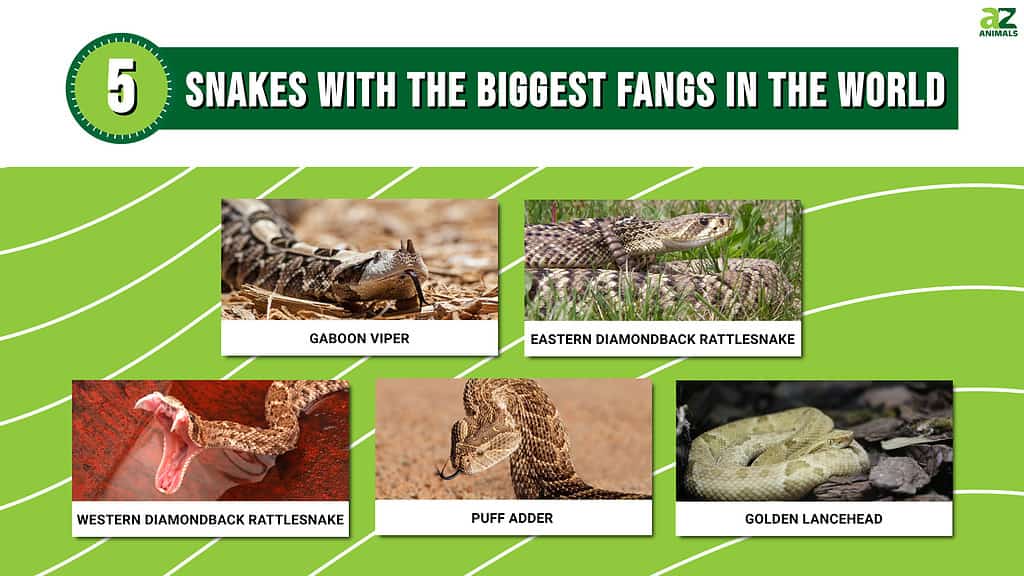
Snakes kill their prey by using their fangs as needles to inject venom into them. This venom contains toxins that work in different ways to kill or injure cells while causing terrible pain.
In this article, we’ll be looking at 6 snakes with the biggest fangs in the world. But before we get into that, let’s check out some interesting facts about snake fangs.
What Are Snake Fangs?

Snake fangs can be grooved or hollow.
©Audrey Snider-Bell/Shutterstock.com
Fangs are sharp and long teeth that are connected to a small sac located behind a snake’s eyes. These sacs contain venom. Snake fangs can be grooved or hollow and work to pass the venom from the sac, through the teeth, and into their prey’s punctured skin or eyes- in the case of spitting cobras.
Most species of snakes have teeth that perform various functions but only venomous snakes have fangs. When a snake bites or spits, the venom is released into its prey and gets right to work. Snakes have varying degrees of venom which is why some snake bites are survivable and others, fatal.
Did you know: In many countries, snakes are caught or raised and milked for venom. People use their venom to create venom antidotes and medications. This doesn’t affect the snakes since they continue to produce venom as long as they’re alive.
Types Of Fangs
There are three major types of venomous snakes – Vipers, Elapids, and Colubrids – and each type has a fang that is unique to it.
Solenoglyphous
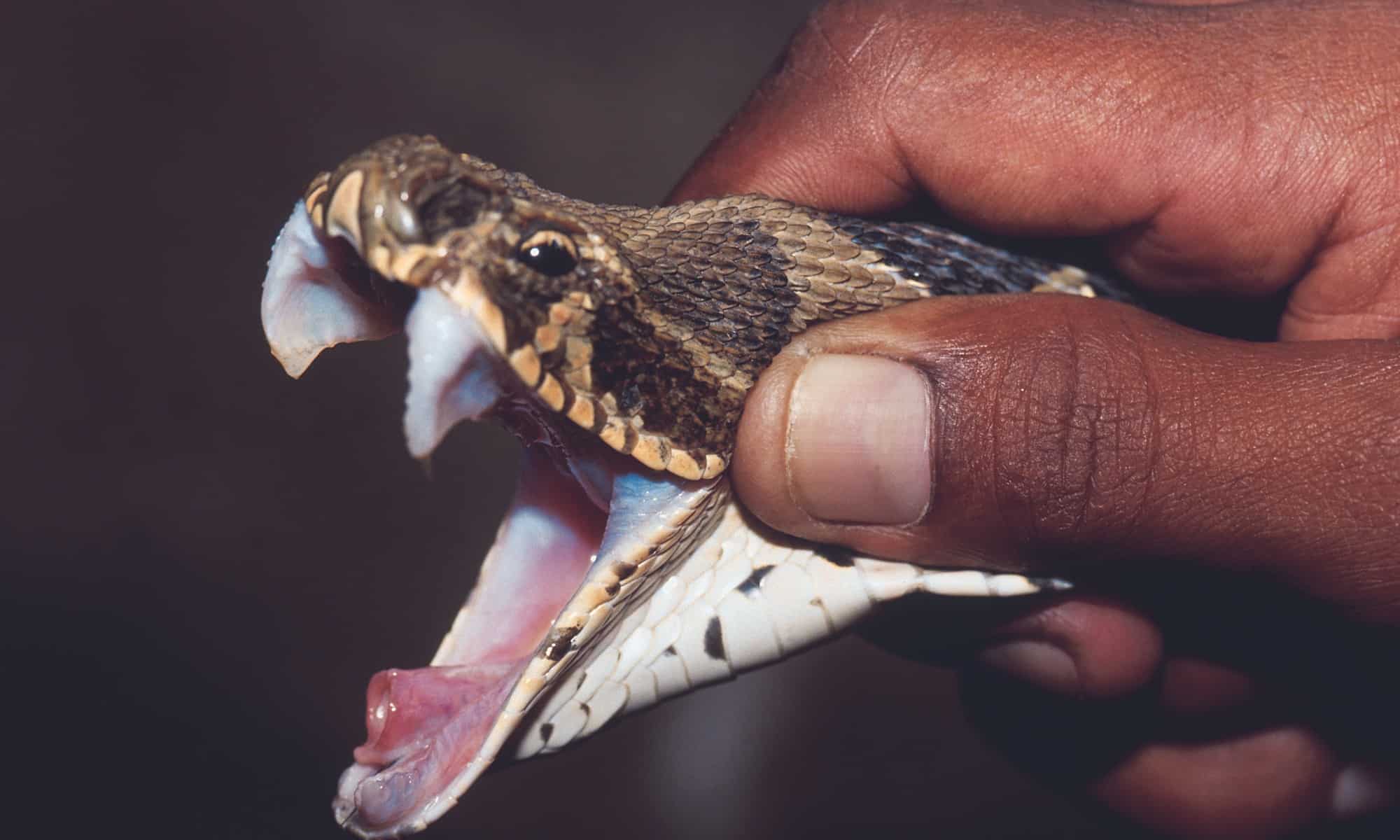
Russell’s Viper displaying erect fangs. These fangs are enclosed in a protective mucous sheath, and are kept folded at rest.
©iStock.com/ePhotocorp
Solenoglyphous fangs are found on vipers. They are hollow, foldable, and designed to inject their venom as deep as possible. This type of fang is often compared to hypodermic needles (the common types used in hospitals) due to how they transmit and inject their venom.
They transmit venom from the snakes into their prey faster than any other fang. Their long and hollow forms help them lock their victims in their jaws long enough to bite and transmit the venom through openings in their teeth. Solenoglyphous fangs create deep wounds which allow the venom to get even deeper into their prey. They are the longest and most dangerous fangs found in snakes.
Proteroglyphous
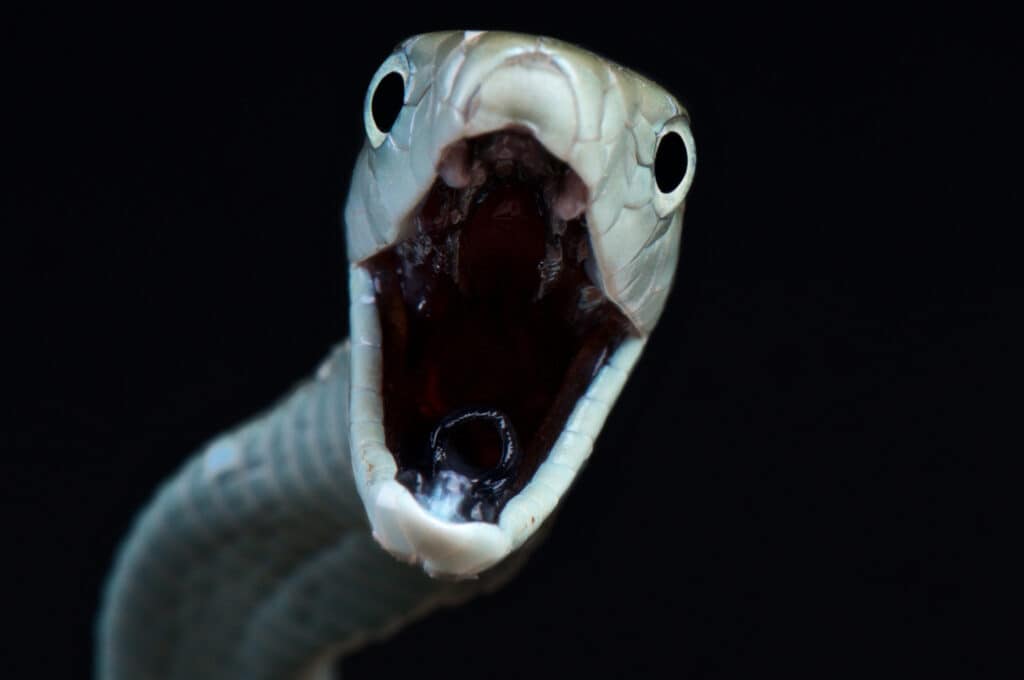
Black mamba fangs are fixed and can’t be extended or moved.
©reptiles4all/Shutterstock.com
Proteroglyphous fangs are found in the Elapid family of snakes. This family includes black mambas, sea snakes, cobras, and several others. Proteroglyphous fangs cannot be extended or moved. Since they are fixed, they are much shorter than solenoglyphous fangs. However, some snakes with this type of fang emit venom at higher speeds than those with solenoglyphous fangs. Snakes with proteroglyphous fangs can also have more than one fang in their tooth pockets. This allows them to hold on to their prey tightly and inject more venom into them.
Opisthoglyphous

Worm snakes have fangs at the back of their mouths.
©Mike Wilhelm/Shutterstock.com
The colubrids group mostly contains snakes of the Xenodontinae subfamily, making them too many to list. Some popular ones are worm snakes, mud snakes, and ringneck snakes. Their fangs are located at the back of their mouths. These snakes must chew on their prey to get their poison in. While this makes most of their bites non-lethal, several dangerous species such as twig snakes fall into this category.
Did you know: Snakes can actually choose not to release venom when they bite. This is called a “dry bite”. Snakes use dry bites in self-defense- when they aren’t interested in eating the prey but in escaping.
5 Snakes With The Biggest Fangs In The World
Generally, the size of a snake’s fang depends on how large the snake is. However, some snakes still have fangs that stand out in size. Since vipers have Solenoglyphous fangs, snakes in this group have the biggest fangs in the world. Here are five vipers with the biggest fangs in the world.
The Gaboon Viper
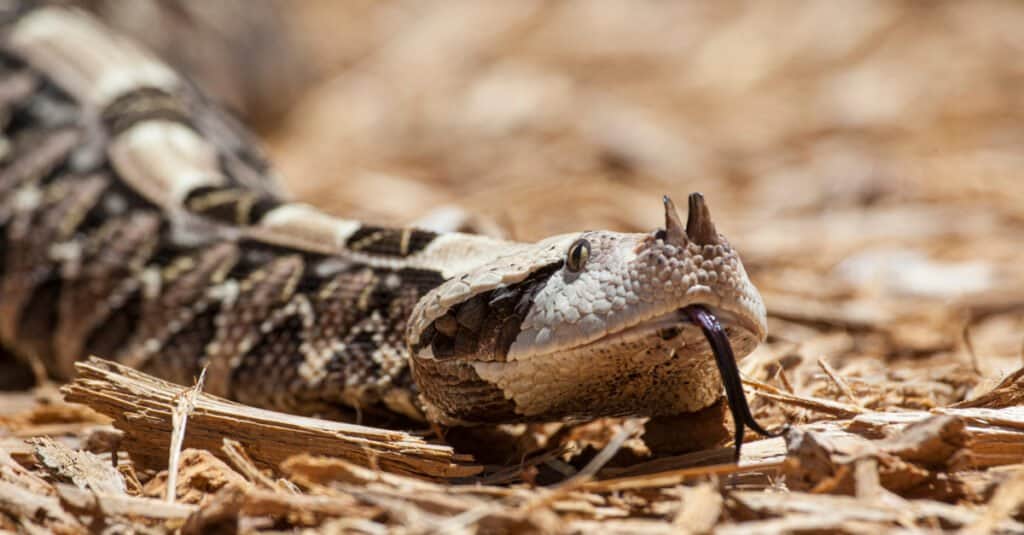
Gaboon vipers have the longest fangs and highest venom yield found in any snake species.
©Danita Delimont/Shutterstock.com
Found in rainforests as well as the savannas of sub-Saharan Africa, the Gaboon viper takes first place on our list. It has the longest fangs and highest venom yield found in any snake species. The Gaboon viper’s fangs have been known to grow up to 2 inches!
The Eastern Diamondback Rattlesnake
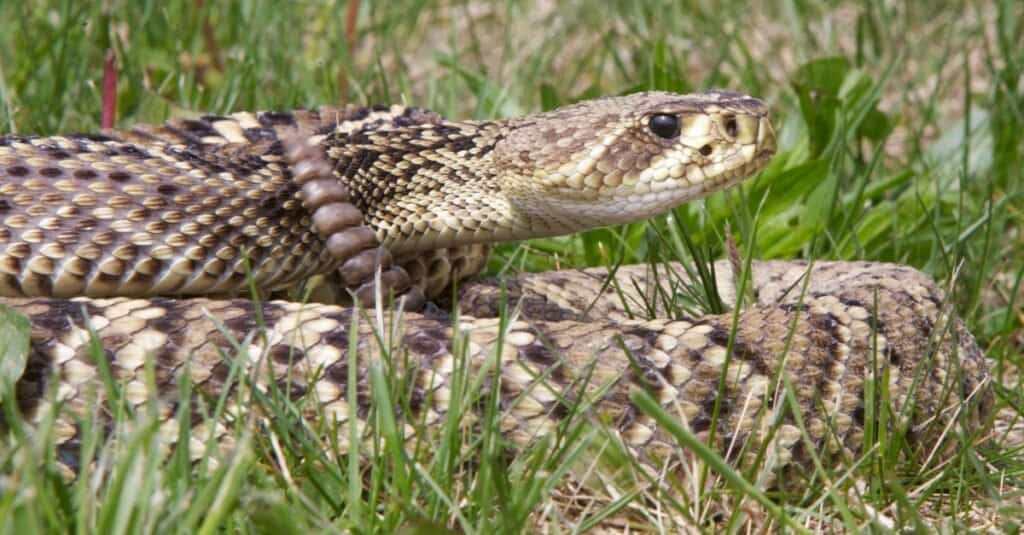
Eastern diamondback rattlesnakes are endemic to the southeastern parts of the United States.
©iStock.com/NajaShots
Although eastern diamondback rattlesnakes usually have fangs that are about an inch large, they make this list for a special reason. This snake species has a high fang-to-body length ratio. Since adult eastern diamondback rattlesnakes usually measure about 4 feet, one would expect that their fangs would measure only about 0.75 inches.
Eastern diamondback rattlesnakes also have high venom yields. On average, they deposit about 400–450 mg of venom per bite, with a maximum of 858–1,000 mg.
The Western Diamondback Rattlesnake

Western diamondback rattlesnakes have retractable fangs that they replace when they break.
©Audrey Snider-Bell/Shutterstock.com
Western diamondback rattlesnakes are usually about four feet long and have fangs that measure 0.75 inches. However, some have been found to have fangs as long as 1.25 inches long!
When threatened, a western diamondback rattlesnake will rattle and coil before striking. An average bite from this species will release between 250 and 350 mg of venom. Sometimes this can go up to 800 mg!
Puff Adder

Known for their cranky temperaments and extremely painful bites, puff adders are found in the semiarid regions of Africa and Arabia.
©iStock.com/EcoPic
Puff adders measure about 3 feet as adults. These venomous snakes have fangs as large as 0.79 inches. In Africa, they are responsible for more snake bites than any other species. Their venom yield is usually 150–350 mg, with a maximum of 700- 750 mg.
Mostly, puff adders eat rodents, birds, lizards, small mammals, and toads. They attack their prey by waiting patiently to ambush them. Puff adders have been known to lie in wait for their prey for weeks.
Golden Lancehead

Snake Island is the only place in the world that is home to the golden lancehead.
©Nayeryouakim / Creative Commons – License
Golden Lanceheads grow to around 28 inches in their adult stages. Commonly found in Brazil, these poisonous vipers have golden-colored scales and triangular heads. Their fangs usually measure 0.79 inches, allowing the snake to insert its venom deeply after breaking its prey’s skin. They are highly dangerous and should be reported to the authorities if spotted.
Fangless Snakes
Nonvenomous snakes do not have fangs. Some, like a few egg-eating snakes, don’t even have teeth. Here are a few fangless snakes:
- Dasypeltis
- Indian Egg-Eating Snake
- Milk Snake
- Green Snake
Summary Of The 5 Snakes With The Biggest Fangs In The World
| Rank | Snake | Fang Length |
|---|---|---|
| 1 | Gaboon viper | <2 inches |
| 2 | Eastern Diamondback Rattlesnake | <0.75 inches |
| 3 | Western Diamondback Rattlesnake | <1.25 inches |
| 4 | Puff Adder | <0.79 inches |
| 5 | Golden Lancehead | <0.79 inches |
Other Animals With Big Fangs Found In The World
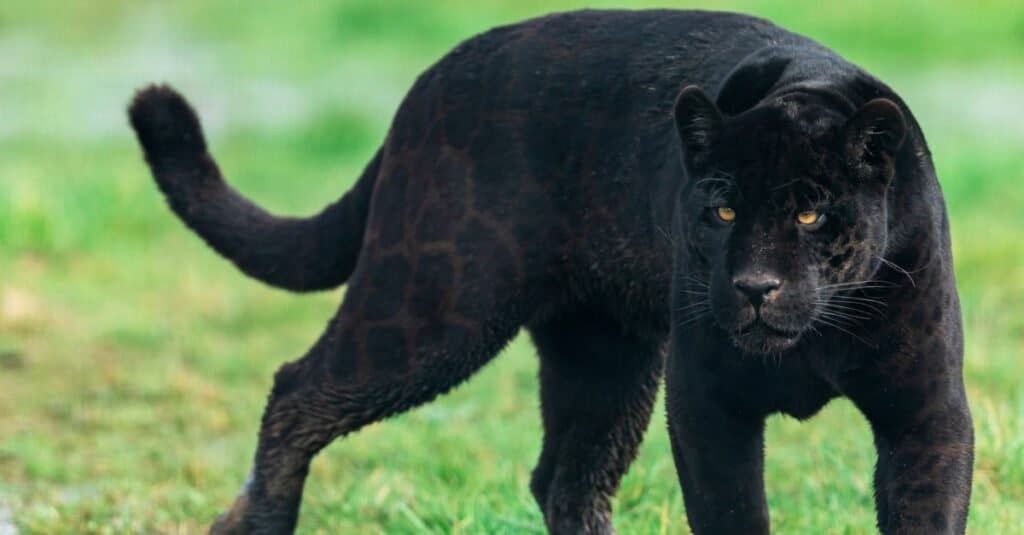
A black panther is a type of
jaguar
with large teeth.
©AB Photographie/Shutterstock.com
The big cat family contains many animals that have some of the largest fangs or teeth in the world. Not only are they impressive to behold, but their fangs have become so refined throughout the years that they have become advanced weapons, as these large cats are the main hunters. The black panther, which is a blanket term used to describe a black leopard or a black jaguar, can run up to speeds of 35 miles per hour and is able to leap up to 20 feet in pursuit of prey. They use their strong jaws, that have a bite force of 200 pounds per square inch (psi), to tear apart their prey.

©iStock.com/sneil375
It may not seem like a baboon would have an impressive set of fangs but this monkey has quite the terrifying array of pearly whites. Although baboons use these teeth to hunt and eat small animals, they play a larger role in their lives – fighting and defending their territories. The apex leader of the group is generally the one that has the largest set of fangs. When these mammals are threatened, they will flip back their lips and gums in order to expose their intimidating, large teeth.
The photo featured at the top of this post is ©
Discover the "Monster" Snake 5X Bigger than an Anaconda
Every day A-Z Animals sends out some of the most incredible facts in the world from our free newsletter. Want to discover the 10 most beautiful snakes in the world, a "snake island" where you're never more than 3 feet from danger, or a "monster" snake 5X larger than an anaconda? Then sign up right now and you'll start receiving our daily newsletter absolutely free.
Thank you for reading! Have some feedback for us? Contact the AZ Animals editorial team.






